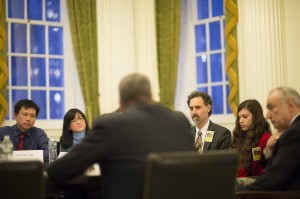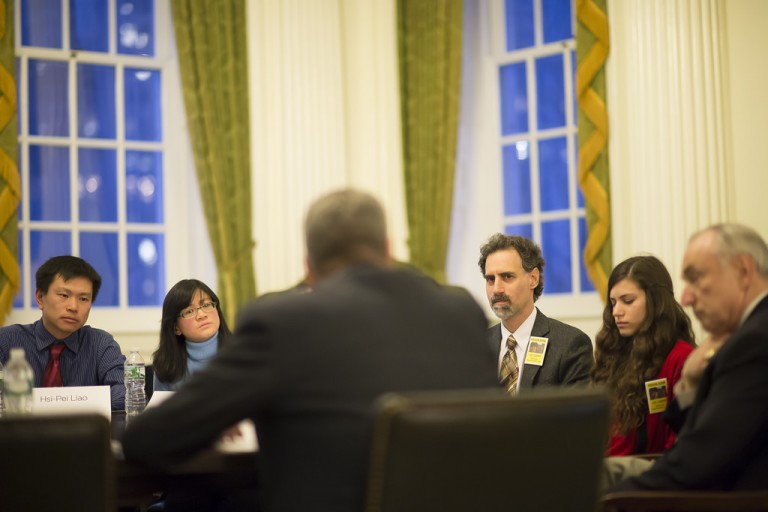
Mayor Bill de Blasio meets last week with families of city residents who have been killed in pedestrian accidents. Photo courtesy Rob Bennett/NYC Mayor’s Office
Reducing the citywide speed limit from 30 miles per hour to 25 mph and expanding the use of speed and red light cameras throughout the five boroughs were two proposals detailed in Mayor Bill de Blasio’s “Vision Zero” action plan that he and his administration rolled out Tuesday afternoon as part of an effort to significantly curb pedestrian deaths.
“We refuse to accept the loss of children, parents and neighbors as inevitable,” de Blasio said at a press conference in Manhattan. “We are focusing the full weight of city government to prevent fatalities on our streets. This will add up to much more than changing intersections or issuing violations. It’s about each of us taking greater responsibility every time we get behind the wheel or step out onto the street. Our lives are literally in each other’s hands – and today we begin the work of living up to that responsibility.”
The mayor joined Police Commissioner Bill Bratton and city Department of Transportation Commissioner Polly Trottenberg, among other administration and elected officials, for the announcement that de Blasio was releasing the Vision Zero plan – the culmination of a month of efforts on the part of city representatives to develop new strategies to make streets safer, ranging from lowering the citywide speed limit to increasing enforcement against speeding and failure to yield to pedestrians.
The effort, which follows the mayor’s meeting last week with families of victims of fatal pedestrian accidents, including a number from Queens, comprises new legislation, changes to city policies, public education, and community outreach.
“More than 20 lives have been lost in our streets so far this year,” de Blasio said Tuesday. “The statistics are sobering. Being struck by a car is the leading cause of injury-related death for children younger than 15. It’s the second leading cause of injury-related death for our senior citizens.”
Last year, de Blasio pointed out, there were 333 recorded homicides – and 286 traffic fatalities.
“Those two numbers are shockingly similar,” the mayor said.
One of the proposed changes includes slashing the citywide speed limit from 30 mph to 25 mph – something for which the mayor will need to receive the blessing of Albany to implement. Numerous studies have shown that the likelihood of an individual surviving after being hit by a vehicle moving at 25 mph is far greater than had they been run into by an automobile traveling at 30 mph.
Additionally, de Blasio and Bratton said they plan to expand the use of speed and red light enforcement cameras. The city currently has the authority to deploy red light cameras at 150 intersections and speed enforcement cameras at 20 spots. Building on the recent success expanding these surveillance programs, city officials said they will work with state leaders to authorize wider use of camera enforcement. Since speed enforcement cameras were activated last month, the city has issued nearly 4,000 speeding tickets.
In addition to speed limits and cameras, city officials are proposing developing borough specific street safety plans – for which the DOT will work with area elected officials, community boards and other stakeholders to address dangerous locations. They will target 50 locations per year for extensive redesign.
De Blasio noted he also aims to expand neighborhood “slow zones,” and the DOT will work with communities to identify and implement 25 new arterial slow zones and eight new neighborhood slow zones that use signage and calming measures like speed humps to minimize speeding.
“Over the last five years, it’s apparent that 70 percent of incidents involving pedestrian fatalities involved the issue of speed or failure to yield,” Bratton said. “And that – the department’s efforts going forward will focus very significantly on those types of violations, speeding violations and failure to yield to pedestrians at intersections.
“We will be enforcing many rules and regulations, but that is the one we feel – coupled with the technology that’s being acquired, increased red light cameras, etcetera – that can have the quickest and most significant impact in reducing…pedestrian fatalities,” Bratton continued.
By Anna Gustafson

